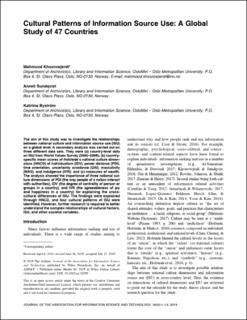Cultural Patterns of Information Source Use: A Global Study of 47 Countries
Peer reviewed, Journal article
Published version
Permanent lenke
https://hdl.handle.net/11250/2761689Utgivelsesdato
2019Metadata
Vis full innførselSamlinger
Originalversjon
Journal of the Association for Information Science and Technology. 2020, 71 (6), 711-724 10.1002/asi.24292Sammendrag
The aim of this study was to investigate the relationships between national culture and information source use (ISU) on a global level. A secondary analysis was carried out on three different data sets. They were (a) country-level data on ISU from World Values Survey (2005–2009); (b) country-specific mean scores of Hofstede's national culture dimensions (HNCD) of individualism (IDV), power distance (PDI), time orientation, uncertainty avoidance (UAI), masculinity (MAS), and indulgence (IVR); and (c) measures of wealth. The analysis showed the importance of three national culture dimensions of PDI (the way people of a nation interact with authorities), IDV (the degree of centrality of person or groups in a country), and IVR (the agreeableness of joy and happiness in a country) for explaining the cross-cultural differences of ISU. The findings were explained through HNCD, and four cultural patterns of ISU were identified. However, further research is required to better understand the complex relationships of cultural factors, ISU, and other societal variables.

